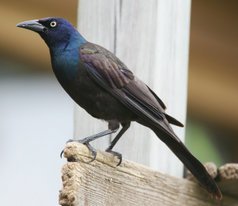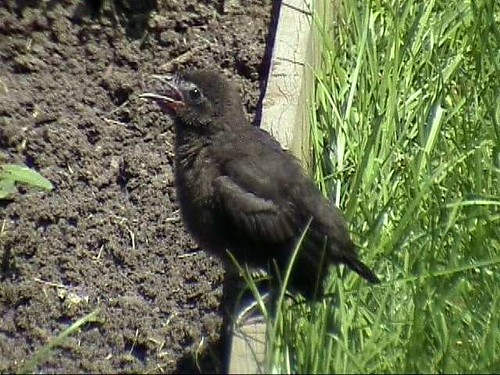
5:49 p.m. - 2007-04-24
A bird that could piss you off.
Greetings, Critter Readers!
How are you? I love springtime! It's so amazing how quickly the leaves unfurl and grow.
This weekend R and I took a nature walk with plenty of creature sightings and photos. (Entry to follow.) I am saddened to admit the following: I do not know where the muskrats are.
Do you?
Critter news:
Well, maybe: a new planet!
Save the Sumatran Rhino!
Is this the fungus that is living on R's foot?!
An old-ass tree.
Today we must turn our attention to a creature that is pissing off one of my friends, JS. At her job in urban Texas, great flocks of squawking birds have been disturbing her peace. Here is the link JS sent me about the birds.
Her nemesis: The common grackle!
Quiscalus quiscula is a member of the Icterids, which means "the jaundiced ones" in Latin, referring to the yellow plumage in many members of the group. Part of the new world Passerines (perching/songbirds), grackle cousins include orioles, blackbirds and meadolarks.
Grackles are one of the creatures who have benefitted from the civilization of America. Scientists believe the bird used to inhabit wetlands along Midwestern waterways, but when this habitat was settled, grackles increased in number and spread throughout the Eastern U.S.!
These birds are about eleven to thirteen inches long, with longer beaks and tails than blackbirds. One distinguishing feature is their golden eye.
Note the iridescent colors of grackle feathers. Apparently male birds are slightly larger and glossier than females. There are several U.S. varieties, which include color variations moving towards bronze or blue, along with melanistic birds with white patches.
JS's main pet peeve has to do with the screeching of these birds, which apparently sounds like a rusty gate! Plus, grackles flock together in groups of a thousand or more to roost at night. That means, lots of noise!
Grackles split up into pairs each spring. The couples are monogamous and perform mating displays and fly around together until the female has completed a nest. Once she's done, the birds do it and she lays one to six eggs. After about twelve to fourteen days of incubation, half of the males leave. The other half will stay to help with the baby grackles when they hatch.
The babies are brownish-black with brown eyes, and are fledged after about two weeks. The parents keep feeding the babies for several more weeks once they have left the nest.
Grackles are aggressive birds. They eat a variety of foods, including insects, grain, eggs and nestlings of other birds, bats, lizards, amphibians, coastal invertebrates and plants. When on the ground, grackles walk, instead of hopping like other birds. They have been seen stealing worms from robins, as well as killing smaller birds. Some farmers consider grackles pests as they enjoy corn.
Enemies of the grackle include JS, other humans, hawks and owls. Grackle eggs are preyed upon by snakes, raccoons, squirrels, chipmunks and cats.
Scientists consider grackles to be helpful as they disperse seeds and can control insect populations.
Well, I'm sure you'll see these birds in your hood! (I think some of them make a nest above my apartment stairs, and poop on the stoop!) Look for their yellow eyes and mean-ass attitude.
JS, I don't know if this entry will make you happy or ANGRY at the evil birds!
Huggies to all!
Wendell!
|


